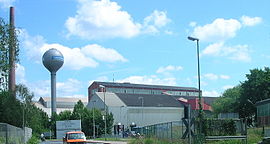Saint-Gobain Glass Germany
| SAINT-GOBAIN GLASS Deutschland GmbH | |
|---|---|
| legal form | GmbH |
| founding | 1853 |
| Seat | Stolberg (Rhineland) , Germany |
| Number of employees | approx. 2,000 |
| Website | https://de.saint-gobain-building-glass.com/de |
The Saint-Gobain Glass Germany GmbH is a company based in Stolberg and belongs to the group Saint-Gobain .
The company produces, transforms and sells glass for building construction (under the company name Saint-Gobain Glass ) and the automotive market (under the company name Saint-Gobain Glass Sekurit ). It supplies special glasses for aviation, electrical household appliances, commercial deep freezing and optics.
The company is represented in Europe and America in a total of 33 countries as well as in China, India, Korea, Japan and Thailand and has a total of 35,000 employees. In Europe it is at the top in float glass production and number 2 worldwide. The construction activities of the Vitrage industry are grouped under the name Saint-Gobain Glass .
National societies
The national companies produce and sell basic products ( float , colored, coated, laminated, mirrored and ornamental glasses) under the common name of Saint-Gobain Glass with the addition of the name of the country concerned.
The national societies were involved in various important European building projects, such as the pyramid in the Louvre , the European Parliament , the Greater London Authority , the opera houses in Beijing and Shanghai and the Chancellery in Berlin .
history
The company began in the mid-19th century: in 1853, Saint-Gobain founded a mirror manufacturer in Mannheim and leased another in Aachen and Stolberg. 80 years later, VEGLA Vereinigte Glaswerke GmbH emerged from these two companies together with two other glassworks.
Although the production facilities were completely destroyed in World War II, the company grew continuously between 1945 and 1950 due to construction activity and the upswing in automobile manufacturing in Germany. In 1952, the main agency responsible for Germany and Central Europe, VEGLA GmbH Aachen, took over as a subsidiary of the special glass factory established there by Ferdinand Kinon and founded by his father in 1871, which from then on traded under the name Kinon GmbH Aachen . With this, Saint Gobain also received the patent rights for the laminated safety glass patented in 1909 by the chemist Édouard Bénédictus , which Ferdinand's brother Viktor Kinon had acquired in the meantime in 1927. Kinonglas was a leader in bulletproof glass for war tanks, colored laminated glasses for aviator goggles and laminated safety glass .
In 1965 the first German float glass plant was put into operation in Cologne-Porz . In 1966, for example, VEGLA was the first German glass manufacturer to commission a float glass system - a production process that revolutionized flat glass production and paved the way for modern functional glass.
In the 1970s, VEGLA became a 100% subsidiary of Saint-Gobain, and the German flat glass production of Glaceries de Saint-Roch was also taken over and all sales and administrative offices were merged in the new company headquarters in Aachen.
An extensive investment program was started in 1982 and 1983. In addition to two new float glass systems in the Cologne-Porz and Herzogenrath plants , a high-vacuum system for the coating of glass was also built in Cologne-Porz. The production lines for car glass were also expanded. The most modern plant for the production of car glass in Europe is located in Herzogenrath. In 1994 the entire automotive glass business was taken over by the newly founded subsidiary "Sekurit Saint-Gobain Deutschland" and the company name was changed again in 2000 as part of the internationalization of construction activities.
Today the company operates four float plants with fully automatic tub guides that are accurate to a fraction of a temperature: in Herzogenrath, Cologne-Porz, Stolberg and in Torgau in Saxony. In a fully continuous process, each system produces up to 750 tons of glass a day - with a 4 mm glass thickness that corresponds to around 67,000 square meters.
This float glass, also known as base glass, is processed into multifunctional glass for the automotive industry and the building construction market. Two magnetron coating systems are available in Cologne-Porz and Torgau to convert the float glass into thermal insulation and sun protection glass . The plants in Herzogenrath and Stolberg primarily produce thin glass for the automotive industry. Another plant and at the same time the largest production facility for cast glass in Europe is located in Mannheim. In June 2020 the company announced that it would stop production in Mannheim by mid-2021 at the latest, as the location could no longer be operated economically due to a lack of demand for the glass produced there.
The group also includes a total of 28 building glass branches from the areas of trade, processing and assembly. Under the uniform company name "Saint-Gobain Glass Deutsche Glas", these branches meet customer requirements through a comprehensive network of decentralized operations.
The company employs around 2,000 people. In December 2014 the company moved its headquarters from Viktoriaallee in Aachen to Stolberg. The parent company Saint-Gobain has been based on the grounds of the Old Tivoli in Aachen since September 2015 .
Individual evidence
- Glass manual MEMENTO (PDF; 6.2 MB)
- ↑ Glass from Stolberg (PDF; 1.0 MB)
- ↑ Mannheimer Morgen from June 25, 2020, page 17, glass factory closes - a piece of history ends
- ↑ Innovative new building

